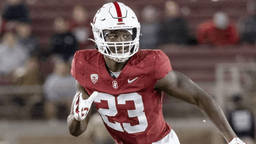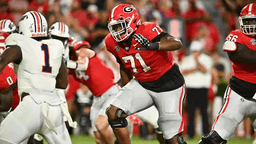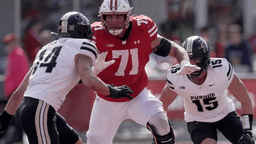Penguins’ College Prospects Hope to Make Their Mark in Hockey’s Big Dance
The Penguins had four prospects from three different college teams involved.
1y

Photo: Wisconsin Badgers
It is no secret in hockey ranks that the Pittsburgh Penguins have among the thinnest pool of prospect talent developing. All recent general managers from Ray Shero to Ron Hextall have followed the dictates of the previous Mario Lemieux led ownership group. Win the Stanley Cup now and worry about the future when it arrives. A primary tool in accomplishing that mission was to sacrifice draft picks, usually in the first round, for experienced veterans needed to plug holes in the lineup.
Three Stanley Cup championships make that approach impossible with which to argue. Parades for prospects is a trade any general manager would make. A downturn for a hockey franchise can coincide when a team’s best players begin to age out of their prime years. A greater accelerant occurs when complimentary players prove to be no longer viable contributors and replacements cannot be found in prospect ranks. Going multiple years without highly drafted prospects that carry less risk of busting is the downside to chasing a Cup. GMs must be creative in keeping a farm system from becoming completely barren.
A favorite tactic of the Penguins going back to General Manager Craig Patrick is to draft players in the later rounds with intriguing skills but with deficiencies to their games. Sometimes, that player would be from Europe. Others would come from a developmental league such as the US National Development Team or the United States Hockey League (USHL). These players usually had a commitment to play college hockey. This assisted in development by having prospects play against more mature and physically imposing opponents. This approach also bought Penguin general managers time. Players drafted out of Canadian Junior leagues must be signed to Entry Level Contracts within two years of their selection or they go back into the draft or become unrestricted free agents. Players who matriculate to college do not have to be signed until after their eligibility has exhausted.
There are no guarantees in drafting teenagers. Frequently, a late round selection does not round out their game and at the end of their college careers, they go about their life’s work. Sometimes, that work takes them to playing years in minor hocky leagues or overseas. However, sometimes a team strikes gold with a prospect like Jake Guentzel. Guentzel was a third round pick, 77th overall, and played collegiately at the University of Nebraska-Omaha. Even if the prospect doesn’t blossom into a legitimate NHL superstar. Players from college ranks can fill out bottom six roles or be moved for players of greater value as was the case of Josh Archibald, also from Nebraska-Omaha, and Scott Wilson, who played at UMass-Lowell. Both were seventh round picks.
College hockey prospects tend to toil out of the spotlight. Their progress is followed by family, friends, and their fellow college students. However, once a year, they have a chance to shine. The NCAA has their own version of March Madness with their national championship tournament. That tournament concludes this weekend with the “Frozen Four” at the Xcel Energy Center in St. Paul, MN. The Penguins had four prospects from three different college teams involved.
The only prospect still playing is Tristan Broz of the University of Denver. His Pioneers will face the Boston University Terriers in a semifinal match up. After he was drafted by the Penguins in the 2nd round, 58th overall, of the 2021 NHL draft, the Bloomington, MN native enrolled at his home state University of Minnesota. His freshman year saw him produce 11 points in 36 games. Disillusioned with his playing time and role, Broz transferred to Denver. He saw more ice time and production as a sophomore but was still considered a disappointment. He changed that perception in his junior year. In 40 games for the Pioneers Broz has scored 15 goals and 24 assists. He is +20 at even strength. His goal in double overtime against UMass send Denver to the second round to meet Cornell. He also has displayed versatility this season. Earlier in the year, Broz was deployed as a second line winger. Injuries thrust him into the role of first line center. He has been used on the primary power play and penalty kill. He has been called upon to take key draws late in games and in overtime. Broz has thrived under the increased pressure. He has one year of eligibility remaining. but the Penguins should give serious consideration to signing him this offseason. If he returns to Denver for his senior year, they run the risk of him spurning any contract offer and becoming an unrestricted free agent. For a team lacking overall depth throughout their system, the Penguins should not chance letting a potential middle six forward escape for nothing.
When Broz and the Pioneers reached the second round, they were matched up against the Cornell Big Red. On the Cornell roster was freshman fourth line center and 2022 draft pick Luke Devlin. The 6’3”, 196 pound native of Memphis, TN was taken in the 6th round, 182nd overall. Before playing for Cornell, he was a member of Des Moines of the USHL and St. Andrews College of the CAHS. Devlin already possesses NHL size. He skates well for his size and plays the game intelligently. He has captain leadership skills. Devlin is responsible defensively and gives maximum effort in each game. He will need to improve his scoring touch if he hopes to see top line duty professionally. Devlin tallied eight points in 29 games for the Big Red. He has the size, speed, and grit to be an effective lockdown center and top-flight penalty killer. He will remain with Cornell through at least his junior campaign.
The only program featuring Penguins’ prospects that did not win a game in the tournament was the Wisconsin Badgers. Wisconsin featured two prospects in right wing Cruz Lucius and defenseman Daniel Laatsch. They are completely different players. Lucius was one of the key pieces acquired from the Carolina Hurricanes in exchange for Guentzel. If nothing else, he vaults to the top of the list of great names among Penguins’ prospects. His offensive upside is legitimate. Lucius likes to shoot the puck and is good at doing so. In 36 Badger contests, he scored 34 points. That is a promising ratio for a sophomore at the collegiate level. Of his 13 goals, five came on the power play and one was a game winner. His game is not pure offense. Lucius is responsible in his own end and displays above average play awareness and anticipation. He effectively uses his 6’0”, 178 pound frame. Lucius needs to overcome a slight injury bug and improve his skating if he is to crack the Penguins line up down the road. If he does, the Grant, MN native will sell a ton of jerseys.
Of the four Penguins’ prospects playing in the post-season, Laatsch is the most intriguing due to his 6’5” frame. Laatsch was selected in the 7th round, 215th overall in 2021. He hails from Altoona. But not the one in Pennsylvania. His hometown is in Minnesota. Laatsch is till quite raw. His height should indicate a player comfortable with physical play. His 190 pounds tell another story. He tends to rely more on his reach than his body. He tries to separate the opponents from the puck with a poke check. This leads to a tendency of being caught flatfooted and susceptible to ill-advised pinches. His skating his sufficient to recover from those gaffes, but they must be limited for him to become a legitimate prospect. He is sound on the outlet and makes intelligent and crisp passes to start the rush. The Badgers use the left handed shot on their second defensive pairing and is a fixture on their penalty kill. It would be surprising if the Penguins offered the junior a contract this summer. Laatsch needs more time to develop physically and add more offensive to his game. It would not be a shock if they signed him to an AHL deal or let him walk altogether.
Drafting players and following their development in college isn’t the only means of procuring talent form the collegiate ranks. Players who have never been drafted are free to sign with any organization upon the completion of their NCAA eligibility. The Penguins did that recently with another Wisconsin Badger, forward Mathieu de Saint Phalle. The 24-year-old alternate captain scored 27 points in 38 games this season. The 5’9”. 170 righthanded shot from Greenwich, CT was signed to a two-year AHL deal with the Wilkes-Barre/Scranton Penguins. He has already potted a goal in three games for the Baby Pens. He is a depth piece who will be invited to Penguins’ training camp in the fall.
Projecting how prospects will eventually impact an NHL roster is difficult regardless of how and when the player is acquired. Any of these players could eventually see regular playing time at PPG Paints Arena. It is equally likely that they spend their careers in Wilkes-Barre/Scranton or Wheeling. It is possible they are never signed by Penguins’ management. So long as their rights are retained by the organization, they have a chance to be part of the next round of the Boys of Winter.





Comments:
Log in or sign up to read and post comments.